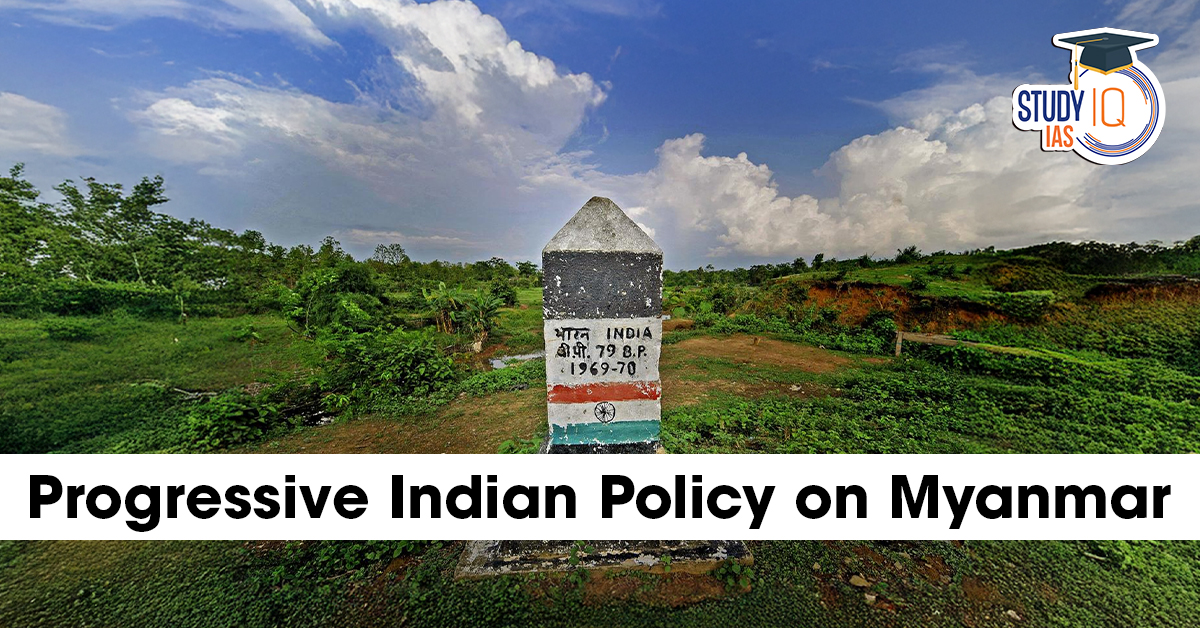Table of Contents
Context: In light of the Myanmar junta ending the state of emergency and announcing elections for December—even as a complex civil war continues—India must recalibrate its foreign policy towards Myanmar to strengthen its influence over its eastern neighbour.
China’s Strategic Backing of Myanmar’s Junta
Motivation: Preserve Chinese interests in Myanmar, especially strategic infrastructure under One Belt One Road (OBOR).
Support Includes
- Diplomatic and political pressure on Ethnic Armed Organizations (EAOs).
- Supply of arms, aircraft, drones, and communication technologies.
- Training pilots and deploying technicians to Myanmar’s defence sector.
- Stationing private security personnel at key OBOR infrastructure like Kyauk Phyu Port in Rakhine State.
India’s Emerging Strategic Opportunity
- Due to: Rising anti-China sentiment among Myanmar’s ethnic minorities and the Bamar majority.
- Reason: China’s coercive tactics — including border closures, supply disruptions, and military support to the junta — have alienated large sections of the Myanmar population.
- Implications for India: A strategic opening to engage with resistance groups, support inclusive development, and counter Chinese influence in its immediate neighbourhood.
Significance of Myanmar for India
- Strategic Location:
- Shared Border: India and Myanmar share a 1,643 km-long border with four northeastern states — Arunachal Pradesh, Nagaland, Manipur, and Mizoram.
- Gateway to Southeast Asia: Myanmar is a vital link for India’s Act East Policy and a bridge to ASEAN.
- Geopolitical Buffer: Acts as a strategic buffer between India and China.
- Myanmar’s tilt towards China increases India’s security concerns, especially in the Bay of Bengal and northeastern borders.
- Security Concerns:
- Insurgency in Northeast India: Some Indian insurgent groups (like NSCN-K, ULFA) have used Myanmar territory as a safe haven.
- Counterterrorism coordination with the Myanmar Army has been critical for operations like Operation Sunrise.
- Economic & Connectivity Interests:
- Natural resources: Myanmar is rich in oil, gas, timber, and rare earths.
- India seeks to secure energy imports and investment opportunities.
- Enhancing land-sea connectivity through Myanmar is crucial for trade with ASEAN.
- Natural resources: Myanmar is rich in oil, gas, timber, and rare earths.
- Cultural and Ethnic Linkages: Strong people-to-people links, especially among Chin, Kuki, and Mizo communities across the border.
- Buddhist cultural heritage strengthens soft power ties.
Key India-Myanmar Projects and Agreements
- Kaladan Multi-Modal Transit Transport Project: Connects Kolkata port to Sittwe Port (Myanmar) by sea, then to Mizoram via river and road.
- Aims to reduce dependence on the Siliguri Corridor for Northeast India’s connectivity.
- India-Myanmar-Thailand Trilateral Highway: 1,360 km highway connecting Moreh (Manipur) to Mae Sot (Thailand) via Myanmar.
- Part of the broader plan to integrate India with ASEAN.
- Border Area Development Projects: India supports infrastructure development (roads, schools, health centres) in Sagaing and Chin regions of Myanmar to promote stability and development.
How India Should Recalibrate Its Myanmar Policy Post-2021 Coup
- Support Democratic Forces Strategically: Engage with the National Unity Government (NUG) and ethnic groups pushing for federal democracy.
- Provide capacity-building, legal aid, and technical support for constitution drafting and governance reforms.
- Leverage India’s Democratic Federal Model: Share India’s experience in managing multi-ethnic federalism, which is relevant as Myanmar’s opposition seeks to replace the 2008 military-drafted constitution with a federal democratic one.
- Stop Arms and Fuel Supplies to the Junta: Immediately halt sales of dual-use/military goods to the junta, which uses them against civilians.
- Aligns India with international norms and distances it from China’s transactional engagement.
- Humanitarian Assistance & Border Policy Reform: Reinstate Free Movement Regime (FMR) for border tribes.
- Open cross-border aid corridors in Mizoram and Manipur, modelled on Thailand’s humanitarian corridors.
- Collaborate with UN agencies and NGOs to provide aid without junta control.
- Protect Asylum Seekers and Refugees: Uphold the principle of non-refoulement, halt deportations, and treat those fleeing as refugees, not illegal migrants.
- Set up humane refugee shelters, especially in Northeast states with shared ethnic kinship.
- Outmaneuver China through Values-Based Diplomacy: Unlike China’s authoritarian alliance with the junta, India can become the champion of federal democracy and human security in Myanmar.
- This will boost India’s soft power, secure goodwill, and maintain influence in the region.
Conclusion
India must go beyond realpolitik and transactional diplomacy in Myanmar. By anchoring its Myanmar policy in democracy, human security, and regional solidarity, India can:
- Reclaim moral leadership in Southeast Asia,
- Counterbalance China’s growing clout,
- Strengthen its Act East Policy, and
- Enhance regional stability that directly impacts India’s own border security.


 Iran Nuclear Crisis and India’s Role f...
Iran Nuclear Crisis and India’s Role f...
 H1B Visa Program, Beneficiaries, Eligibi...
H1B Visa Program, Beneficiaries, Eligibi...
 Comparison Between India & France's ...
Comparison Between India & France's ...

























